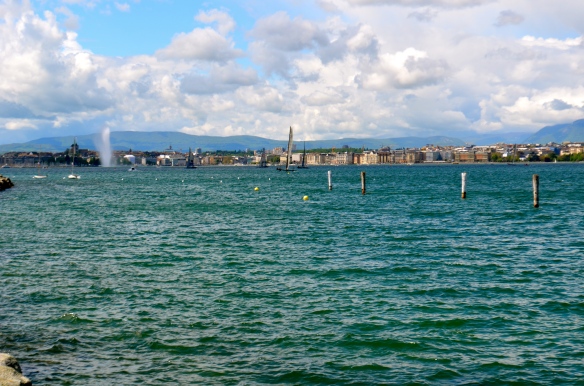Switzerland has many large beautiful lakes surrounded by mountains. Even though it is a landlocked country, the Swiss can sail. They had a team, Alinghi, win the America’s Cup in 2003 and 2007. They sail on Lac Leman, the lake on which Geneva is situated.
Alinghi is the syndicate set up by Ernesto Bertarelli, racing under the colors of the Société Nautique de Genève. They set it up “to win the America’s Cup, while earning respect and recognition as a world-class sports team as well as sharing our passion”. Not surprisingly, not all the team was Swiss. They hired Russell Coutts, the successful skipper and helmsman of Team New Zealand (who won the America’s Cup for New Zealand in 1995 and successfully defended in 2000) and several other important Kiwi sailors, (including tactician Brad Butterworth and Grant Simmer). Apart from New Zealand, the Alinghi team consisted of members from: Germany, the United States, Canada, the Netherlands, France, Italy, Spain, the U.S. Virgin Islands, Portugal,Turkey, Ireland, the UK (from Scotland and Wales), Belgium, South Africa, Australia, Uruguay, Argentina, Denmark, Ecuador, and Switzerland.
Not only did they splurge on the team, they shelled out for boats (SUI-64, the race boat, and the SUI-75). They were developed specifically for the race by the Alinghi team in close collaboration with the École Polytechnique Fédérale de Lausanne , were developed.
On March 2, 2003, Alinghi sailed to a 5-0 victory against Team New Zealand (ironic, huh) winning the America’s Cup. They were the first team to win the Cup on its first attempt. They were also the first European team since the 1851 inaugural race to return the Auld Mug.
Immediately prior to this, After winning they (via America’s Cup Management) changed the rules to prevent any team members from moving between teams until completion of the next America’s Cup (which as the holders, they could do) and promptly fired it winning Skipper Russell Coutts. The rule change prevented him for sailing for another team in the cup.
In the 2007 America’s Cup, the team had many highly experienced members including: Brad Butterworth as tactician, Jochen Schümann, Peter Holmberg, Ed Baird, Juan Vila, Jordi Calafat, Warwick Fleury, Simon Daubney, and Murray Jones. Although they did well in the Match Race, they were defeated by Emirates Team New Zealand in the second race, but won their final race, defending the America’s cup with 5 wins to Team New Zealand’s 2. They won their last race by only 1 second!
As a result of this win, the International Olympic Committee awarded them the Coupe Olympique, the Olympic Cup, in 2003. One of the highest honors in sports, it is awarded to awarded institutions or associations with a record of merit and integrity in actively developing the Olympic Movement.
Alas, we couldn’t see them race in this year’s cup (even though there’s been plenty of publicity about there only being two teams competing, why the race was different this year, and opinions of the changes) which just took place in San Francisco. The team was disbanded in July 2010,. Don’t worry, there is still lots of sailing on the lake. If you’re not in Geneva, there’s sailing on other lakes so you can see it in Zurich, Lugano and other cities too.







































































